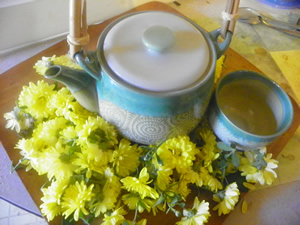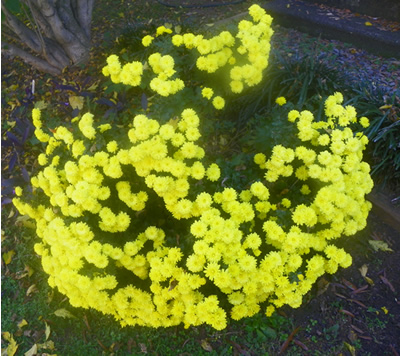Chrysanthemum Chrysanthemum morifolium, C. sinense

Chrysanthemum morifolium
- Common Names
- Chrysanthemum , Mums, Ju Hua, Chu Hua,Florist's Chrysanthemum
- Botanical Name
- Chrysanthemum morifolium, C. sinense
- Syn. Dendranthema morifolium
- Family
- ASTERACEAE
Medicinal Uses & Benefits of Chrysanthemum
![]() How to Use|
Side Effects |
Plant & Garden|
How to Use|
Side Effects |
Plant & Garden|
- Medicinal Uses: * Allergies
* Ayurvedic
* Cardiovascular
* Eyes/Vision
* Flu
* Hypertension
* Sore Throat
- Properties: * Anti-inflammatory * Antibacterial * Aromatic * Demulcent * Febrifuge * Hepatic * Hypotensive * Refrigerant
- Parts Used: flowers
- Constituents: ascorbic acid, beta-carotene, calcium, fiber, folacin, iron, magnesium, niacin, potassium, riboflavin, essential oils.
How to Use: Chrysanthemum
We value the chrysanthemum for their burst of fall color that signals the approach of winter, but like many ornamental plants, chrysanthemums have an ancient reputation in the East as a medicinal plant.
Preparation Methods & Dosage : When making the tea, steep the flowers gently in hot water for no more than 10 minutes in a closed vessel, to preserve the essential oil. Powder may be taken in capsule form.
Chrysanthemum Remedies
Traditional Chinese Medicine
 Ju-hua is used in Chinese medicine in prescriptions for colds with wind, and
heat, headache, inflamed eyes, swelling and pain in the throat, vertigo, tinnitus,
sores such as boils, and tightness of the chest with anxiety. Chrysanthemum
flowers soaked in rice wine are a historical restorative drink. Chrysanthemum
is combined with Japanese honeysuckle in the treatment of high blood pressure. 1
Ju-hua is used in Chinese medicine in prescriptions for colds with wind, and
heat, headache, inflamed eyes, swelling and pain in the throat, vertigo, tinnitus,
sores such as boils, and tightness of the chest with anxiety. Chrysanthemum
flowers soaked in rice wine are a historical restorative drink. Chrysanthemum
is combined with Japanese honeysuckle in the treatment of high blood pressure. 1
Ayurvedic Medicine
 Sevanti Chrysanthemum flower is a cooling anti-Pitta remedy with an affinity for the head. It cools pitta in the eyes and helps vision. 3
Sevanti Chrysanthemum flower is a cooling anti-Pitta remedy with an affinity for the head. It cools pitta in the eyes and helps vision. 3
Chrysanthemum Side Effects: None noted
Plant Description

Fall yellow mums in bloom
Mums are the undisputed queen of the fall flowers, and are one of the most cultivated flowers in America. Chrysanthemum are one instance where the botanical name has become the common name, shorted to "mums". The genus name Chrysanthemum was published by Linnaeus in 1753, combined the Greek words chrysos, meaning gold with anthemon, meaning flower. These ancient species, bear little resemblance to today's showy blooms. The earliest illustrations of mums show them as tall, leafy plants with small, yellow daisy-like flowers.
Regional Traditions :Ayurvedic * Traditional Chinese Medicine *
How to Grow Chrysanthemum
Rich well drained soil in a sunny, sheltered spot. Many cultivars need to be protected from cold temperatures in the winter. Propagate by cuttings in the spring. Flowers are gathered in in autumn. The Chinese steam the flowers before drying to reduce bitterness.












